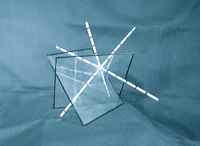Difference between revisions of "Plane"
| Line 9: | Line 9: | ||
*[http://mathworld.wolfram.com/Plane.html Plane] | *[http://mathworld.wolfram.com/Plane.html Plane] | ||
*[http://easyweb.easynet.co.uk/~mrmeanie/plane/planes.htm Polygons & the Plane Equation] | *[http://easyweb.easynet.co.uk/~mrmeanie/plane/planes.htm Polygons & the Plane Equation] | ||
| + | |||
| + | [[Category: Mathematics]] | ||
Revision as of 16:41, 3 September 2010
In mathematics, a plane is any flat, two-dimensional surface. A plane is the two dimensional analogue of a point (zero-dimensions), a line (one-dimension) and a space (three-dimensions). Planes can arise as subspaces of some higher dimensional space, as with the walls of a room, or they may enjoy an independent existence in their own right, as in the setting of Euclidean geometry.
When working in two-dimensional Euclidean space, the definite article is used, the plane, to refer to the whole space. Many fundamental tasks in geometry, trigonometry, and graphing are performed in two-dimensional space, or in other words, in the plane. A lot of mathematics can be and has been performed in the plane, notably in the areas of geometry, trigonometry, graph theory and graphing.[1]
